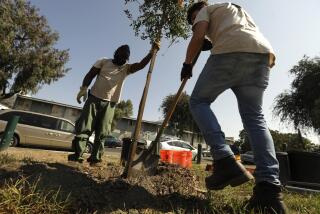A Matter to Chew On : More thought about nutrition wouldn’t hurt LAUSD menus
- Share via
Often missed in the heated debates over how we can better educate youngsters is the fact that schools are responsible for feeding both minds and bodies. The Los Angeles Unified School District, if a study by a health food advocacy group is correct, is doing a poor job on the latter.
After reviewing menus and nutritional analyses, the District of Columbia-based Physicians’ Committee for Responsible Medicine ranked LAUSD’s cafeterias as second-worst among the nation’s large school systems in providing healthful meals. Too much fat and not enough fruits, vegetables and high-fiber foods, it said.
Warren Lund, director of the L.A. district’s food services branch, denounced the study and the stature of its authors. Indeed, the Physicians’ Committee (composed mainly of non-physicians) is not a mainstream group. In addition to campaigning against drinking milk, it has aggressively lobbied for the redefinition of the four food groups to reflect “a plant-based diet”--fruits, vegetables, grains and beans.
The committee’s study fails to credit the district’s efforts, as documented in a recent study by the state Department of Education, to put more vegetables and fruits on cafeteria trays. And its emphasis on low-fat diets is not necessarily a valid criterion for those poor children who get little food except the school lunch.
Nevertheless, the study does highlight some genuine problems. The district’s efforts to increase protein in students’ diets, for instance, center almost exclusively on meat, milk and meat alternates like eggs and cheese. All of these are high-fat items. None of the food service managers interviewed by The Times reported any efforts to turn to low-fat sources of protein like tofu, beans and chickpeas.
District nutritionist Laura Chinnock told a Times reporter: “If we have to serve 1,000 kids in 30 minutes, we can’t do a salad bar.” But New York City, the only district in the country larger than Los Angeles Unified, provides salad bars in all secondary schools.
L.A. district nutritionists said that in addition to providing nutritious meals, they aim to teach students to eat a balanced diet at home. But the best crusaders on this educational front often have come from outside school district headquarters. Crusaders like Crenshaw High School, which manufactures a creamy Italian salad dressing from produce grown organically on campus. And like Alice Waters, a master chef who has been lobbying state officials to establish a garden in every public school. Her idea is to teach children that food fresh from the soil tastes better than processed foods from the supermarket. It is a goal the district would do well to pursue.
More to Read
Eat your way across L.A.
Get our weekly Tasting Notes newsletter for reviews, news and more.
You may occasionally receive promotional content from the Los Angeles Times.










